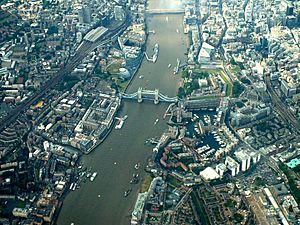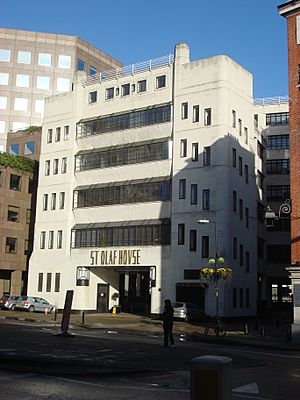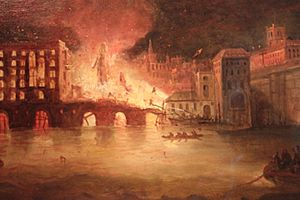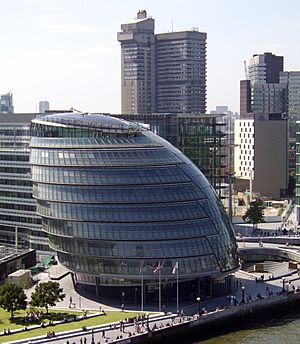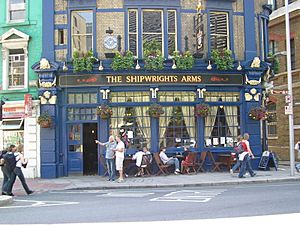Tooley Street facts for kids

Tooley Street is a busy road in central and south London. It connects London Bridge to St Saviour's Dock. This street runs right past Tower Bridge on the Southwark side of the River Thames. It is also part of the A200 road.
Tooley Street's History
How Tooley Street Got Its Name
The very first name for this street was "royal street." This simply meant it was a public road. Later, around 1561, it was called "Barms Street," which meant the street leading to Bermondsey. During the Stuart period, people called it "Short Southwark." This helped tell it apart from "Long Southwark," which is now Borough High Street.
The name "Tooley" came from the old Church of St Olave. Over time, maps showed the church's name changing to "Synt Toulus," "Toulas," "Toolis," and "Toolies." This is how "Tooley" came to be. The church was named after King Olaf from Norway. He helped Æthelred the Unready fight against Cnut's forces near London Bridge in 1013.
The church was mentioned in the Domesday Book in 1086. It was located a bit east of London Bridge. The church was taken down in 1926. In its place, the Hay's Wharf Company built their main office, "St Olaf House." This office building was constructed between 1929 and 1931 in the Art Deco style. It even has a story and a painting of Saint Olaf inside.
Tooley Street does not end where it meets Borough High Street, as many people think. That part of the road is actually Duke Street Hill. Tooley Street actually joins Montague Close under the arch of London Bridge.
The Great Tooley Street Fire
A huge fire started on Tooley Street on June 22, 1861. It began in a warehouse at Cotton's Wharf. The fire burned for two days and destroyed many buildings nearby. It took two whole weeks for the fire to go out completely!
At that time, the fire brigade was run by insurance companies. James Braidwood, the head of the fire brigade, sadly died when a wall fell on him while he was fighting the fire. This was one of the biggest fires in London during the 1800s.
After the fire, insurance companies raised their prices. They even threatened to stop running the fire brigade. Finally, the government agreed to take over. The Metropolitan Fire Brigade Act was passed in 1865. This led to the first public fire service in London, which became the London Fire Brigade.
George Orwell's Visit
In the early 1930s, the famous writer George Orwell lived like a homeless person. He wanted to understand what poverty was really like. He made friends with a man named Ginger in the hop-fields of Kent. They came to a cheap lodging house, called a "kip," on Tooley Street. They stayed there from September 19 to October 8, 1931.
Orwell wrote his rough notes in the lodging house. Then he went to Bermondsey Library, which was also on Tooley Street. There, he wrote his notes into his famous book, Down and Out in Paris and London. The library building was torn down in the 1980s. Now, that spot is part of an open area called Potter's Fields.
Hay's Wharf: London's Larder
Hay's Wharf was a very famous dock on the south side of the Pool of London. It was first mentioned in 1651, east of St Olave's church. For 300 years, it grew bigger and bigger. Tooley Street and the businesses around it became known as "London's Larder." This meant it was like London's giant food storage area.
The warehouses at Hay's Wharf burned down in the great fire of 1861. In 1921, Ernest Shackleton's ship, the Quest, was docked here. In the 1980s, this dock was filled in during a big rebuilding project. Now, it is a shopping area called Hay's Galleria. The office building next to it is named "Shackleton House." Nearby, at No. 27, is the private London Bridge Hospital. It is located in the St Olaf House building.
Old Punishments and New Attractions
A map from 1542 shows a few things on Tooley Street. One of them was a pillory. This was a device used to punish traders who cheated people. Next to it was a "cage." This was a place to hold people who were arrested for being noisy or causing trouble. They would stay in the cage until they were sober.
Until 2013, the spot where these old punishments happened was home to the London Dungeon. This was a popular place for tourists. It opened in 1975 and was similar to the "Chamber of Horrors" at Madame Tussaud's Museum. The London Dungeon moved to County Hall in 2013.
In nearby Stainer Street, which runs under the main train station, there is a blue plaque. This plaque remembers the 68 people who died in a bombing raid in 1941. Stainer Street has now been closed forever as part of the London Bridge station changes. Another museum and tourist spot has been created under London Bridge. It is called 'The London Bridge Experience and London Tombs.' One part shows the history of the Bridge, and the other part is a fun show, like the 'Dungeon.'
John Keats and Weston Street
Before it was closed off in 2012, Weston Street connected to Tooley Street. This was done to make way for the London Bridge station changes. In the early 1800s, before the station was built, the famous poet John Keats lived on Weston Street. At that time, it was called Dean Street. He lived there when he was a medical student at Guy's Hospital. It was here that he wrote his poem "On First Looking into Chapman's Homer."
Modern Tooley Street
London Bridge City and More London
From 1987 to the early 1990s, and again from 1999 to 2009, new buildings were built between Tooley Street and the river. In 1987, the area was bought by the St Martins Property Group. This was part of their London Bridge City project. This project stretches from London Bridge east to English Grounds. This development has really improved the area.
Later, a new area called More London was created. It is a walking area that connects Tooley Street with London City Hall. From Tooley Street, you can see amazing views of Tower Bridge, the Tower of London, and City Hall. A children's theatre called The Unicorn Theatre has been built here. "The Scoop" is an outdoor amphitheater at More London. Many events like plays, music, and outdoor movies are held there in the summer.
Besides City Hall, many important companies are based here. These include Visit London, Ernst and Young's European Headquarters, and a Hilton hotel.
HMS Belfast is a warship docked on the riverfront next to More London. The Queen's Walk is a path along the Thames. It runs along the north side of London Bridge City and More London, from Tower Bridge to London Bridge. This path is part of the Jubilee Walkway.
From 2012, a large new housing project called One Tower Bridge was built. It is located between Potters Fields and Tower Bridge Road. Besides apartments, it has shops, public spaces, a museum, and a hotel in the old St Olave's Grammar School building.
Public Buildings on Tooley Street
London's City Hall opened here in 2000. In 2009, Southwark Council opened its new main office building at 160 Tooley Street. This new building replaced some older council offices.
Local Pubs and Theatres
At the corner of Tooley Street and Bermondsey Street, there is an old pub called "The Shipwright's Arms." Its name reminds us of the shipbuilding industry that used to be in this area. It has a large wall with tiles showing ships being built.
Two new theatres have also been added to the street. The Unicorn Theatre is a special building in the More London area. It puts on shows for young people. The Southwark Playhouse is located in a railway arch behind "The Shipwright's Arms." It moved to Newington Causeway in 2013 because of the train station changes.
Public Art and Memorials
On the corner of Braidwood Street, on a building that is part of the London Bridge Hospital, there is a memorial. It honors James Braidwood, who died in the 1861 fire. Inside the Cottons Centre, an office building near the river, there is a modern piece of art. Also, inside Hay's Galleria, you can find a sculpture and fountain called 'The Navigators.'
More London has three water features. A channel called the Rill runs along the street. Near City Hall, there are 210 fountains. At the Tooley Street end, there are three "Water Tables" that constantly overflow with water. Above these, there is a statue that looks like a real person.
At the fork in the road between Tooley Street, Queen Elizabeth Street, and Tower Bridge Road, there are two statues. One is a bust of Ernest Bevin. He was a trade union leader for dockworkers and a government minister during World War II. The other is a full-size statue of Samuel Bourne Bevington. He was a local leader and a generous person. He was the first Mayor of the Bermondsey area. His statue was put up shortly after he died in 1908.
The Three Tailors of Tooley Street
The saying "The Three Tailors of Tooley Street" is used when a small group acts like they represent many more people than they actually do. This saying comes from a story about three tailors on Tooley Street. They wanted to avoid a local tax. So, they wrote a request to the government, which began with the words, "We, The People of England..." It's interesting that in 1381, most of the workers on Tooley Street were tailors.
London Bridge Station
London Bridge station was first called Tooley Street when it opened in 1836. It was updated between 1972 and 1978. Now, it is being completely rebuilt as part of the Thameslink Programme. This project will move the main entrance from London Bridge Street to a new entrance on Tooley Street. This will create new public walking space next to the More London area. It will also lead south through the old railway arches to St Thomas Street. This work was finished in 2018.
|


